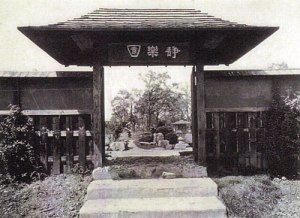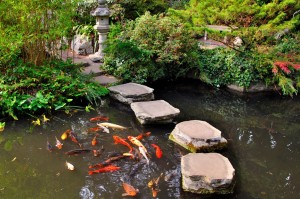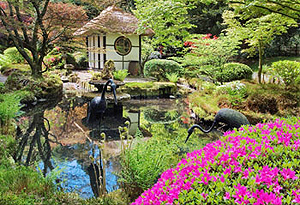 In 1857 Japan opened its borders to visitors, ending centuries of self-imposed isolation. The inquisitive went to visit and returned with new ideas on many subjects. At the age of twenty-four Josiah Conder, an English Architect, went to Japan in 1877 to teach. He was keen to learn about Japanese art and eventually went on to study painting and one of his publication (1893) was Landscape Gardening in Japan. The book turned out to be a bit of hit back home. By 1910 Japanese gardens were becoming very fashionable and the London Japan-British Exhibition, which attracted 8 million visitors in 6 months, had two major gardens on display.
In 1857 Japan opened its borders to visitors, ending centuries of self-imposed isolation. The inquisitive went to visit and returned with new ideas on many subjects. At the age of twenty-four Josiah Conder, an English Architect, went to Japan in 1877 to teach. He was keen to learn about Japanese art and eventually went on to study painting and one of his publication (1893) was Landscape Gardening in Japan. The book turned out to be a bit of hit back home. By 1910 Japanese gardens were becoming very fashionable and the London Japan-British Exhibition, which attracted 8 million visitors in 6 months, had two major gardens on display.
Japanese gardens are rooted in Shinto religion with its story of eight perfect islands and the lakes of the gods, and is also influenced by Chinese philosophy. Japanese traders brought back Chinese garden techniques during the Asuka period (roughly first century). The earliest gardens were the pleasure gardens of the emperors and nobles. In 612 Empress Suiko built a garden with artificial mountain that represented Mount Sumera, which is reputed to be at the centre of the world, according to Buddhists. Japanese gardens is all about combining aesthetics and philosophy to create ancient landscapes, often in miniature settings.
The interest in Japanese gardens spread to the Western world, but often only as a reference to the style, such as a random lantern or bridge, when in fact Japanese gardens are more complex and challenging to create, especially on a large scale. Some of the best designs were at the Cowden Castle (Perthshire, 1907) and Node (Hertfordshire, 1930).

Node Garden
Cowden Castle was inspired by Isabelle Christie (1861-1949), who was the first Western lady to travel to Khiva to meet the Dalai Lama. Often travelling in dangerous times, she always packed dresses in her trunks for parties. She camped in the snow, travelled with cargo ship full of pigs, and trekked 60 miles by foot in the mountains of India. Rather fearless, she was fluent in four languages including Finnish. She travelled around Japan in 1907-08 and this is when she acquired an interest in recreating a Japanese garden back in England. The garden was initially designed by a woman, Taki Handa, and maintained by Professor Suzuki, who regularly visited to prune the trees. The use of the Japanese gardeners continued, and one was employed who’d lost his whole family in an earthquake. He worked there, dressed in pleated trousers, golf stockings, white splats and a velour hat, until his death in 1937. In 1963 the garden was sadly vandalised when the tea houses and bridges were burnt down by teenagers. The garden was handed over to Isabelle’s great, great niece, and in 2010, Taki Handa’s grand-daughter visited. The garden is being restored.

Cowden Castle
The decline of Cowden’s garden is typical. By the mid-twentieth century, many of those early Japanese gardens were lost having fallen out of fashion. Then in the 1960s and 70s, they bounced back on a smaller scale and less ambitious. Who hasn’t seen a little Japanese garden?
There is plenty of symbolism to embrace with natural elements, and while Western landscaping is about visual appeal, the Japanese prefer the spiritual setting. Their gardens have the following features: water, whether through channels, streams or cascades; volcanic rock to represent mountains, smooth round rocks for stepping stones, hard rocks for waterfalls; bridges; stone lanterns and water basins for washing hands prior to the tea ceremony; fences and gates. Trees are trimmed, their growth controlled in a technique called Niwaki which keeps trees looking ancient. Japanese plants and flowers include cherry, pine, bamboo, cedar and azaleas. (I have a set of Japanese Flower cards that represent each of the twelve months with these popular flowers). There are also fishes – carp and goldfish.
Other elements include concealment – hide and reveal features of the garden, and asymmetry – a garden as a work of art to be seen from different angles.
Seyemon Kusumoto was involved in the creation of 200 gardens in the UK. In 1937, he exhibited a rock garden at Chelsea Garden Show. This is just one type of garden, there are many!
The general style of gardens are ponds and islands; dry landscapes, which still represent water; tea gardens; stroll gardens and courtyard gardens.
Pond and Island is the oldest style. Island are considered to be sacred with bridges connecting them.
Dry gardens are associated with Zen temples. Sand or gravel is used to represent water.
Tea gardens involve a path that leads the visitor to the tea house.
Stroll gardens, rather self-explanatory!
Courtyard gardens are about the spaces between gardens or buildings.
In the UK, perhaps two of the most famous Japanese gardens are Compton Acre, which has a tea house,

Compton Acre

Compton Acre
and Tatton Park. Tatton’s is considered the finest with a mound representing the Mount Fuji capped in snow.

Tatton Park

Tatton Park
Japanese gardens always seem to look neat, intricate, rather like a painting and lend themselves well to art. Josiah Conder was awarded with an honorary doctorate and stayed in Japan. He is buried at Buddhist temple hopefully by a nice garden.

Do you like to read about free chapters and short stories, or find out more about your favourite author including their work in progress?
Interested? Then sign up for my reader’s club newsletter: Rachel’s Readers and you’ll receive a complementary short story.









Very enlightening post ….loved it ….
Follow me on the above link
LikeLiked by 2 people
Thanks!
LikeLike
A lovely and informative post. Japanese gardens are a favorite of mine – I always feel a layer of tension leave me when I enter one, as though tranquility were an actual element used in creating it.
LikeLiked by 2 people
I agree, Japanese gardens are very tranquil and always seem to be still, as if frozen in time.
LikeLike
[…] to be one at Cowden gardens in Scotland. This is not my first visit to Cowden as I used it for letter J in a previous blogging challenge using a historic gardens […]
LikeLike